Intel PPSTCK1A32WFC Bay Trail-T Compute Stick Review
by Ganesh T S on April 22, 2015 11:00 AM EST- Posted in
- Systems
- Intel
- Bay Trail
- HDMI Stick
HTPC Credentials
Usage of the Compute Stick as an entertainment platform is promoted by Intel as one of the use-cases. It is a bit surprising (given the form factor) that the Compute Stick has a fan. Subjectively, I was not comfortable with the acoustics in a 'office scenario' with the Compute Stick at the base of the monitor (connected via the HDMI extender cable) and myself seated around 70 cms. from it. The small diameter of the fan makes for a whining high-pitched noise, and it is compounded by the fact that it starts and stops depending on the SoC load.
Objectively speaking, Intel provided an acoustics rating of 28 dB at 1m distance for the noisiest mode. If the Compute Stick were to be hidden behind the TV, it is unlikely that users can hear such low noise at typical television viewing distances. It is not ideal, but Intel indicated that the performance of the device needs proper thermals. In order to to balance the very small size along with overall cost and performance, they went with a small fan as the optimal thermal solution. Now that we have got the acoustics out of the way, let us move on to the other HTPC aspects.
Refresh Rate Accurancy
Starting with Haswell, Intel, AMD and NVIDIA have been on par with respect to display refresh rate accuracy. The most important refresh rate for videophiles is obviously 23.976 Hz (the 23 Hz setting). The Intel PPSTCK1A32WFC has no trouble with refreshing the display appropriately in this setting, but it is not as accurate as Haswell or Broadwell or even other Bay Trail-based systems (refreshing at 23.973 Hz instead of 23.976 Hz).
The gallery below presents some of the other refresh rates that we tested out. The first statistic in madVR's OSD indicates the display refresh rate.
Network Streaming Efficiency
Evaluation of OTT playback efficiency was done by playing back our standard YouTube test stream and five minutes from our standard Netflix test title. Using HTML5, the YouTube stream plays back a 720p encoding. Since YouTube now defaults to HTML5 for video playback, we have stopped evaluating Adobe Flash acceleration. Note that only NVIDIA exposes GPU and VPU loads separately. Both Intel and AMD bundle the decoder load along with the GPU load. The following two graphs show the power consumption at the wall for playback of the HTML5 stream in Mozilla Firefox (v 37.0.1).
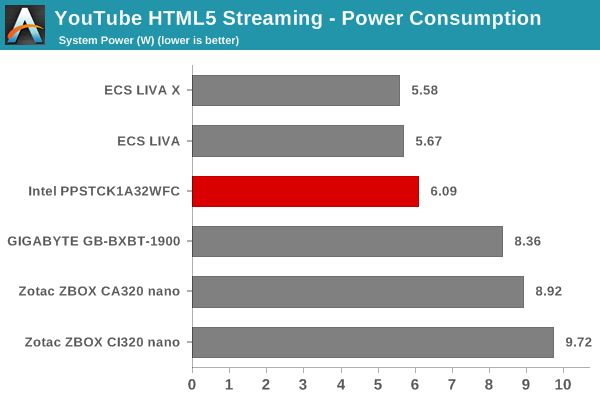
GPU load was around 51.56% for the YouTube HTML5 stream and 4.53% for the steady state 6 Mbps Netflix streaming case. Mozilla Firefox is terribly inefficient in terms of power for YouTube playback. The same test stream, when played back in Internet Explorer, consumed only 3.55 W on an average and had a GPU load of 9.1% for the same H.264 stream.
Netflix streaming evaluation was done using the Windows 8.1 Netflix app. Manual stream selection is available (Ctrl-Alt-Shift-S) and debug information / statistics can also be viewed (Ctrl-Alt-Shift-D). Statistics collected for the YouTube streaming experiment were also collected here. The power efficiency of the Compute Stick platform comes to the fore here.
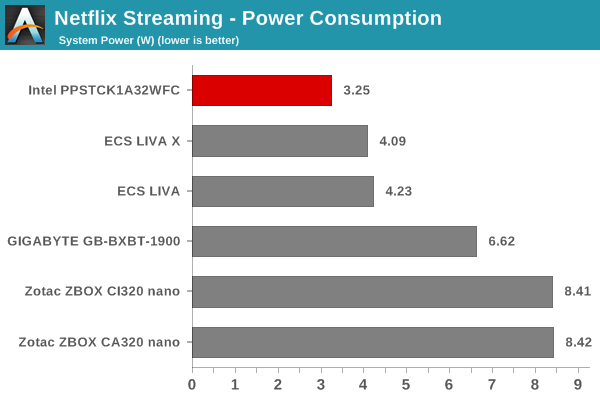
Decoding and Rendering Benchmarks
The form factor of the Compute Stick and the internal components make it clear that consumers are not going to play back videos using the madVR renderer. Instead, it is highly likely that Kodi will be used as the interface for media playback. We evaluated performance under MPC-HC + EVR-CP and Kodi 14.2 for our test suite. Prior to those results, let us take a look at the codecs that are hardware-accelerated by the Bay Trail-T SoC.
As expected, we have acceleration for MPEG-2, VC1, WMV9 and H.264. HEVC is not necessary for such a platform at this point in time.
In our earlier reviews, we focused on presenting the GPU loading and power consumption at the wall in a table (with problematic streams in bold). Starting with the Broadwell NUC review, we decided to represent the GPU load and power consumption in a graph with dual Y-axes. Nine different test streams of 90 seconds each were played back with a gap of 30 seconds between each of them. The characteristics of each stream are annotated at the bottom of the graph. Note that the GPU usage is graphed in red and needs to be considered against the left axis, while the at-wall power consumption is graphed in green and needs to be considered against the right axis.
Frame drops are evident whenever the GPU load consistently stays above the 85 - 90% mark. In addition to tracking that aspect in the graphs below, we also get an idea of the system's power efficiency for decode and playback of some common codecs.
The above graph suggests that the Compute Stick is likely to drop frames when deinterlacing of high frame rate content is required. It is possible that EVR, the native renderer, will perform better than EVR-CP.
Kodi doesn't deinterlace content by default - so, the GPU load goes unreasonably high only for the 1080i60 stream. Another aspect to observe with Kodi is that 'idling' at the XBMC interface consumes around 60% of the GPU resources and the power penalty is around 6 W. Depending on the codec and frame rate, the GPU load and power consumption might be lower or higher than the 'idle' state. For example, 480i60 and 1080p24 videos play back within the 5 W power envelop.
Note on HD Audio Bitstreaming
As of April 2015, the Intel graphics drivers for Bay Trail-T (32-bit) have support only for bitstreaming of DTS, Dolby Digital and Dolby Digital Plus. This means that Netflix and other similar OTT sites are in the clear. However, users hoping to take advantage of lossless HD audio in Blu-ray backups are going to be disappointed. In any case, streaming of Blu-rays over a 802.11n Wi-Fi network will result in a bad user experience. So, it is possible that the absence of HD audio bitstreaming will not bother too many consumers.








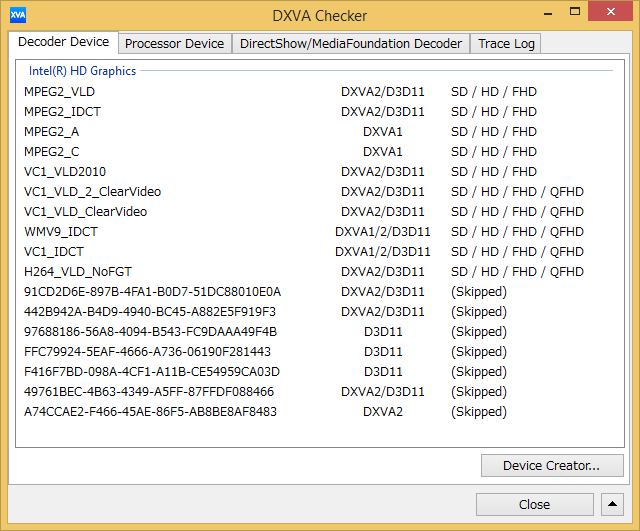
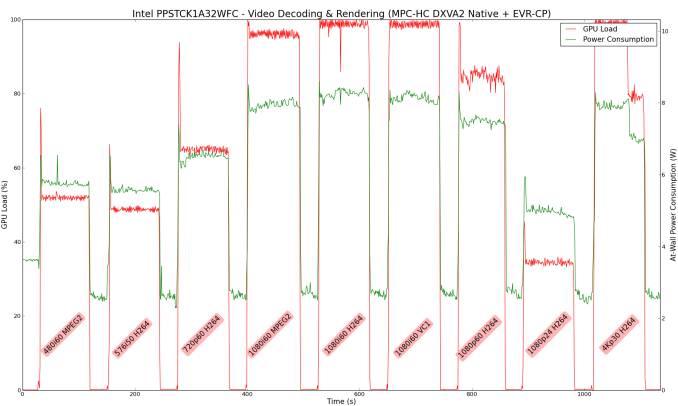
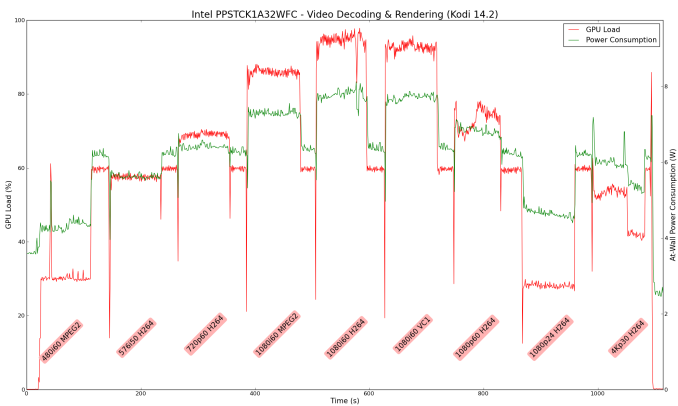








103 Comments
View All Comments
Arnulf - Wednesday, April 22, 2015 - link
Looks like a massive fail, but then again what else to expect from such a small form factor ...kyuu - Wednesday, April 22, 2015 - link
If you think this is a "massive fail", the problem is probably more your expectations than the product.jospoortvliet - Wednesday, April 22, 2015 - link
Or he's comparing it to the competition... Chromecast for one. It might not be as powerful but what it does it does well - without an annoying fan or bad/unreliable wifi. And at a very low price.Yeah, this doesn't impress me either, mostly due to the failure to make this fanless. The drive size is fine (put Linux with Kodi on it) but the bad wlan - that is a fail, too.
Still, yeah, first gen, Intel is good at incremental improvement so I bet gen 2 will be much much better.
JeffFlanagan - Wednesday, April 22, 2015 - link
This isn't something comparable to a Chromecast. Chromecast is an extremely limited device. I've already replaced one with a much more capable Fire stick, and may replace the other with one of these or another low power PC.usernametaken76 - Wednesday, April 22, 2015 - link
I'm going to have to agree with you on that, Jeff. This does what they say it does, and it runs Windows. So you can build and compile your own local applications and there's no need for a "network" operating system like ChromeOS. For some users, that's what they want and/or need. You could easily build a Plex server and run the Plex app on this device and be quite happy, I'll assume. It would be nice to have more of a "user experience" review. Performance metrics are interesting, but if I spend $150 on an HDMI stick, I don't care how fast it can encode video, decrypt files, etc. I care how it will perform as a media streamer, can it run any games (highly limited here), can it be a remote streamer for Steam (unlikely for this first gen device), etc. That's what matters to me for something like this.Deelron - Wednesday, April 22, 2015 - link
The first thing I thought when I saw it was Plex server, but the networking solution isn't sufficient enough in my book. While I guess you could add a USB to Ethernet dongle (or thumb wireless solution), that seems kludgey at best. It's an interesting step towards something more usable in the future.usernametaken76 - Wednesday, April 22, 2015 - link
If you mean "Plex client" with the server running elsewhere, then I think its existing wireless is already sufficient. Plex "tops out" at 20 Mbps for streaming, and that's adjustable in the client all the way down to sub HD speeds < ~3 Mbps. You have the option to transcode everything on the Plex server when doing this, and Intel's stick here would be more than capable of handling that situation, provided there's not a lot of WiFi interference on the 2.4 GHz band. If it's 5 Ghz (admit I didn't read the full specs) then less so, but distance is the issue.bigkev1978 - Wednesday, April 22, 2015 - link
Massive fail seems like a bit harsh... I will admit that I haven't used the Compute Stick but I have had a Hannspree Micro PC (www.stickpcstore.com/stick-pcs/hannspree-windows-8-stick-pc-quad-core-1-83-ghz-2gb-ram-32gb-windows-8-1-micro-pc-snnpdi1b.html) for a couple of months and it is very similar spec to the Compute Stick... and it is great... yes it is not an i5 or i7 PC... but it does "light productivity" really well... Word, Excel, Outlook... browsing the web. I've got in plugged into my front room TV (42") and use it occasionally all the time. I agree the WiFI could be better but hopefully this will be a second gen update.Refuge - Wednesday, April 22, 2015 - link
I was reading MAXPC's review, its up on their site. They don't obviously offer the kind of solid quantifiable metrics that I get here, but they are usually good for a user experience overview.They said that it streamed everything from YouTube, Netflix, Hulu to steam in home perfectly. Playing games with no noticeable input lag, and that it streamed 1080p videos without a problem.
The way they described the fan, is that it was just a high pitched hum that you wouldn't hear unless you were in a dead silent room, which is something that I would never deal with if this were on my living Room TV.
They said they got something like 20 FPS on Portal 1 playing it from the stick itself.
azazel1024 - Wednesday, April 22, 2015 - link
I am a little dissapointed (especially the neutered GPU chops, even compared to other Baytrail SoCs), but at the same time, it seems like it would make a perfectly good LIGHT HTPC. I am not super interested this time around, but if the price stays the same, I might be very interested with Cherry Trail if the drop in process size helps out with maintaining higher frequencies under load, better GPU, etc.